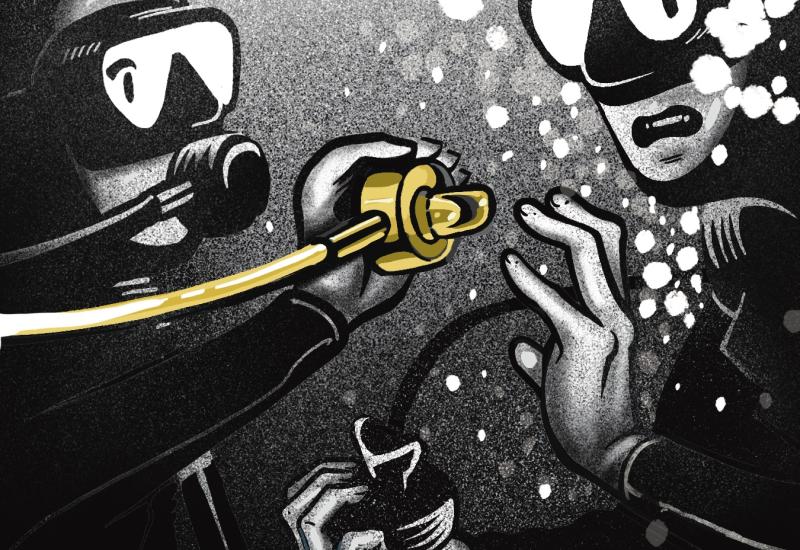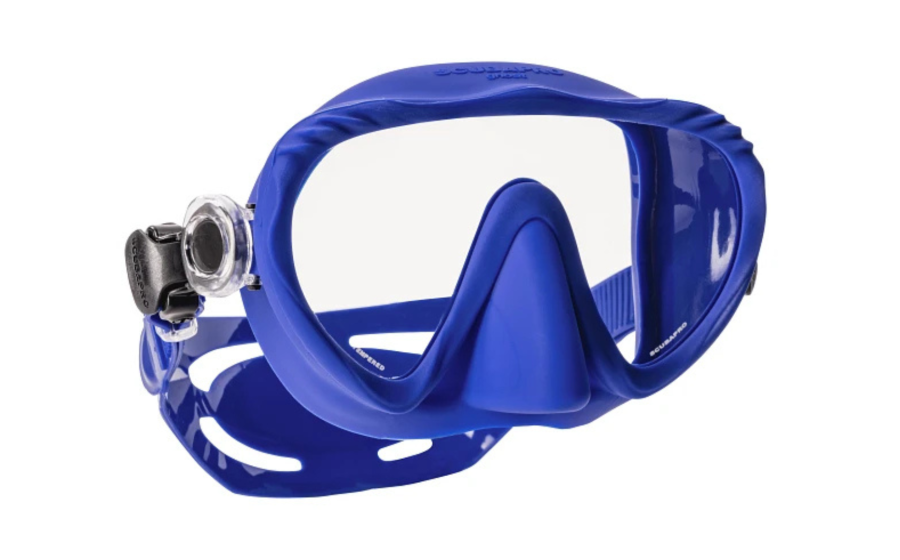River Blindness
April 2004
Colin heard the thrumming propellers coming closer and closer. The noise was almost deafening, but in the dark water he couldn't tell which direction it was coming from and he couldn't see the vessel anywhere around. What had started out as a fun dive for artifacts had quickly turned into a blackwater nightmare. Circling in the water, he searched frantically for the rest of his dive group but found only darkness. Disoriented and confused, Colin finally decided to try to make his escape by submerging deeper into the river channel. He started to descend and felt the pressure wave from the bow only a fraction of a second before the hull of the barge slammed into his body.
The Diver
Colin was an active diver with both civilian and military scuba training. He was in his mid-40s and in excellent health. Colin worked out regularly and dived between 10 and 15 times a year.
The Dive
When invited to dive in nearly black water at a popular river dive site, Colin jumped at the opportunity to get wet. In spite of the poor visibility, the site was popular with local divers as a place to find fossilized sharks' teeth and other artifacts. It was a sweltering summer day and the heat was almost unbearable, even in the early morning hours when the divers boarded the dive boat for the short run downriver. Colin was diving with a group of eight divers and using a charter operation that frequently took guests to the site.
After arriving in the area of the dive, the captain pulled the boat alongside the shore, raised the dive flag and tied up to the bank. He gave a detailed briefing of the site, explaining to the divers that the river had a lot of large boat traffic and that it was necessary either to stay very close to the banks of the river or to stay on the bottom if venturing toward the center of the river.
Colin and some of his buddies were busy assembling gear and apparently missed this part of the briefing. The divers quickly suited up and entered the water in a large group. Colin and several other divers in the group immediately submerged and began sifting silt on the bottom, searching for the elusive artifacts they came to find.
The Accident
Approximately 45 minutes into the dive, the divers realized they had no idea where they were. The group surfaced and were surprised to find that they had nearly crossed the entire span of the river and had moved a substantial distance down current from the dive boat. Each of the divers shot a quick compass heading, and Colin submerged with the group to about 10 or 15 feet to begin the swim back to the boat.
As the dive group crossed the river, a barge rounded a nearby bend. The other divers reported that it was obvious under water that a boat was coming. With only a couple of feet of visibility, the divers became separated as they attempted to descend to the bottom and swim as quickly as possible from the channel of the river. Colin, however, did not submerge deep enough or fast enough. No one in the group was towing a dive flag, and the barge operator had no clue that divers were in his path until he felt and heard the thud of Colin's tank against the hull.
Colin's body rolled to the surface in the wake of the barge. He sustained massive injuries, and although he was immediately recovered by the other divers in his group, it was too late. Colin was already dead.
Analysis
The first mistake Colin's group made was failing to use a dive flag. Both local and federal laws require the use of the internationally recognized alpha flag and, in most cases, the familiar red and white diverdown flag when diving in navigable waters. When a flag is used in a restricted channel such as a river, in most jurisdictions, the divers are required to remain within 50 feet of the flag. Although a flag was prominently displayed on the dive boat, Colin was several hundred yards away from the flag at the time of the accident.
Even if one of the divers had been towing a dive flag, there would have been little the barge operator could have done to avoid the group, given the confining width of the channel and the size of the barge. Colin's group should have heeded the dive captain's advice and remained closer to the banks of the river. Once the mistake became obvious, Colin should have descended all the way to the bottom and waited for the boat to pass.
Lessons For Life
-
Never dive in restricted, navigable waterways where large vessel traffic is likely.
-
Always use a dive flag and remain within the specified circle of protection provided by the flag.
-
Tow a surface marker with a dive flag attached anytime your dive plan requires you to leave the protected area of the surface flag.
-
Dive briefings contain vital information. Stop what you're doing, listen carefully and heed the advice of the crew.
April 2004
Colin heard the thrumming propellers coming closer and closer. The noise was almost deafening, but in the dark water he couldn't tell which direction it was coming from and he couldn't see the vessel anywhere around. What had started out as a fun dive for artifacts had quickly turned into a blackwater nightmare. Circling in the water, he searched frantically for the rest of his dive group but found only darkness. Disoriented and confused, Colin finally decided to try to make his escape by submerging deeper into the river channel. He started to descend and felt the pressure wave from the bow only a fraction of a second before the hull of the barge slammed into his body.
The Diver
Colin was an active diver with both civilian and military scuba training. He was in his mid-40s and in excellent health. Colin worked out regularly and dived between 10 and 15 times a year.
The Dive
When invited to dive in nearly black water at a popular river dive site, Colin jumped at the opportunity to get wet. In spite of the poor visibility, the site was popular with local divers as a place to find fossilized sharks' teeth and other artifacts. It was a sweltering summer day and the heat was almost unbearable, even in the early morning hours when the divers boarded the dive boat for the short run downriver. Colin was diving with a group of eight divers and using a charter operation that frequently took guests to the site.
After arriving in the area of the dive, the captain pulled the boat alongside the shore, raised the dive flag and tied up to the bank. He gave a detailed briefing of the site, explaining to the divers that the river had a lot of large boat traffic and that it was necessary either to stay very close to the banks of the river or to stay on the bottom if venturing toward the center of the river.
Colin and some of his buddies were busy assembling gear and apparently missed this part of the briefing. The divers quickly suited up and entered the water in a large group. Colin and several other divers in the group immediately submerged and began sifting silt on the bottom, searching for the elusive artifacts they came to find.
The Accident
Approximately 45 minutes into the dive, the divers realized they had no idea where they were. The group surfaced and were surprised to find that they had nearly crossed the entire span of the river and had moved a substantial distance down current from the dive boat. Each of the divers shot a quick compass heading, and Colin submerged with the group to about 10 or 15 feet to begin the swim back to the boat.
As the dive group crossed the river, a barge rounded a nearby bend. The other divers reported that it was obvious under water that a boat was coming. With only a couple of feet of visibility, the divers became separated as they attempted to descend to the bottom and swim as quickly as possible from the channel of the river. Colin, however, did not submerge deep enough or fast enough. No one in the group was towing a dive flag, and the barge operator had no clue that divers were in his path until he felt and heard the thud of Colin's tank against the hull.
Colin's body rolled to the surface in the wake of the barge. He sustained massive injuries, and although he was immediately recovered by the other divers in his group, it was too late. Colin was already dead.
Analysis
The first mistake Colin's group made was failing to use a dive flag. Both local and federal laws require the use of the internationally recognized alpha flag and, in most cases, the familiar red and white diverdown flag when diving in navigable waters. When a flag is used in a restricted channel such as a river, in most jurisdictions, the divers are required to remain within 50 feet of the flag. Although a flag was prominently displayed on the dive boat, Colin was several hundred yards away from the flag at the time of the accident.
Even if one of the divers had been towing a dive flag, there would have been little the barge operator could have done to avoid the group, given the confining width of the channel and the size of the barge. Colin's group should have heeded the dive captain's advice and remained closer to the banks of the river. Once the mistake became obvious, Colin should have descended all the way to the bottom and waited for the boat to pass.
Lessons For Life
Never dive in restricted, navigable waterways where large vessel traffic is likely.
Always use a dive flag and remain within the specified circle of protection provided by the flag.
Tow a surface marker with a dive flag attached anytime your dive plan requires you to leave the protected area of the surface flag.
Dive briefings contain vital information. Stop what you're doing, listen carefully and heed the advice of the crew.










